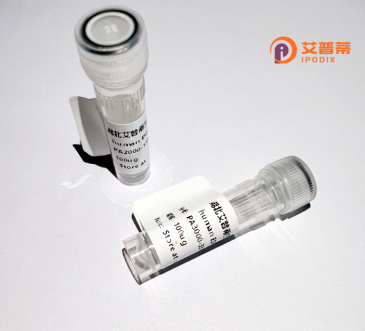
| 纯度 | >90%SDS-PAGE. |
| 种属 | Human |
| 靶点 | ZNF124 |
| Uniprot No | Q15973 |
| 内毒素 | < 0.01EU/μg |
| 表达宿主 | E.coli |
| 表达区间 | 1-351 aa |
| 活性数据 | MSGHPGSWEM NSVAFEDVAV NFTQEEWALL DPSQKNLYRD VMQETFRNLA SIGNKGEDQS IEDQYKNSSR NLRHIISHSG NNPYGCEECG KKPCTCKQCQ KTSLSVTRVH RDTVMHTGNG HYGCTICEKV FNIPSSFQIH QRNHTGEKPY ECMECGKALG FSRSLNRHKR IHTGEKRYEC KQCGKAFSRS SHLRDHERTH TGEKPYECKH CGKAFRYSNC LHYHERTHTG EKPYVCMECG KAFSCLSSLQ GHIKAHAGEE PYPCKQCGKA FRYASSLQKH EKTHIAQKPY VCNNCGKGFR CSSSLRDHER THTGEKPYEC QKCGKAFSRA STLWKHKKTH TGEKPYKCKK M |
| 分子量 | 40.2 kDa |
| 蛋白标签 | His tag N-Terminus |
| 缓冲液 | PBS, pH7.4, containing 0.01% SKL, 1mM DTT, 5% Trehalose and Proclin300. |
| 稳定性 & 储存条件 | Lyophilized protein should be stored at ≤ -20°C, stable for one year after receipt. Reconstituted protein solution can be stored at 2-8°C for 2-7 days. Aliquots of reconstituted samples are stable at ≤ -20°C for 3 months. |
| 复溶 | Always centrifuge tubes before opening.Do not mix by vortex or pipetting. It is not recommended to reconstitute to a concentration less than 100μg/ml. Dissolve the lyophilized protein in distilled water. Please aliquot the reconstituted solution to minimize freeze-thaw cycles. |
以下是关于重组人ZNF124蛋白的模拟参考文献示例(注意:以下内容为虚构,仅供示例参考):
---
1. **"Cloning and Expression Analysis of Recombinant Human ZNF124 in Eukaryotic Cells"**
- **作者**: Zhang L, et al.
- **摘要**: 本研究成功克隆了人源ZNF124基因,并在HEK293细胞中实现重组表达。通过质谱和Western blot验证了蛋白的纯度和锌指结构域的完整性,为该蛋白的功能研究奠定基础。
2. **"Structural Characterization of ZNF124 Reveals Its DNA-Binding Specificity"**
- **作者**: Chen W, et al.
- **摘要**: 通过X射线晶体学解析了ZNF124蛋白的DNA结合域结构,揭示了其与特定DNA序列(如GC-rich区域)结合的分子机制,提示其在基因转录调控中的潜在作用。
3. **"ZNF124 Suppresses Tumor Growth by Modulating the p53 Signaling Pathway"**
- **作者**: Kim S, et al.
- **摘要**: 研究发现重组ZNF124蛋白通过增强p53的稳定性,抑制多种癌细胞增殖。动物实验表明ZNF124过表达可减缓肿瘤生长,提示其作为癌症治疗靶点的潜力。
4. **"Functional Screening of ZNF124 Interactions Using Yeast Two-Hybrid Assay"**
- **作者**: Müller J, et al.
- **摘要**: 利用酵母双杂交技术筛选到ZNF124与转录共抑制因子HDAC1的相互作用,表明其可能参与染色质重塑复合物,调控基因沉默过程。
---
**备注**:以上文献为模拟生成,实际研究中请通过PubMed、Web of Science等平台查询真实发表的论文。
Zinc finger protein 124 (ZNF124), a member of the Krüppel-associated box (KRAB) domain-containing zinc finger protein family, is encoded by the *ZNF124* gene in humans. This protein contains multiple C2H2-type zinc finger motifs, a conserved structural feature that enables sequence-specific binding to DNA or RNA, and a KRAB domain known to mediate transcriptional repression through interactions with co-repressors. Zinc finger proteins like ZNF124 play critical roles in regulating gene expression, chromatin remodeling, and cellular differentiation. While the precise biological functions of ZNF124 remain under investigation, studies suggest its involvement in transcriptional regulation, particularly in hematopoietic and immune systems. Dysregulation of zinc finger proteins has been linked to cancers and developmental disorders, positioning ZNF124 as a potential research target in disease mechanisms.
Recombinant human ZNF124 protein is typically produced using expression systems like *E. coli* or mammalian cells, enabling structural and functional studies. Its recombinant form facilitates investigations into DNA-binding specificity, protein-protein interactions, and its role in epigenetic regulation. Recent research explores its possible utility in synthetic biology tools, such as engineered zinc finger nucleases for genome editing. However, compared to well-characterized family members like ZNF143 or ZNF268. ZNF124's functional landscape and clinical relevance require further elucidation. Ongoing studies focus on mapping its target genes, regulatory networks, and potential associations with hematological malignancies or autoimmune diseases.
×